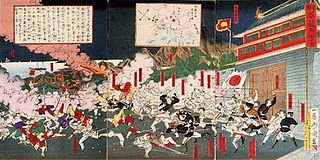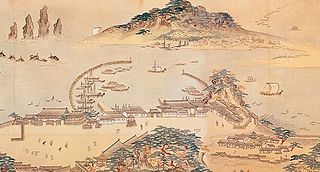
The Treaty of Shimonoseki, also known as the Treaty of Maguan in China and Treaty of Bakan in the period before and during World War II in Japan, was an unequal treaty signed at the Shunpanrō hotel, Shimonoseki, Japan on April 17, 1895, between the Empire of Japan and Qing China, ending the First Sino-Japanese War.

The First Sino-Japanese War or the First China–Japan War was a conflict between the Qing dynasty and Empire of Japan primarily over influence in Korea. After more than six months of unbroken successes by Japanese land and naval forces and the loss of the port of Weihaiwei, the Qing government sued for peace in February 1895.
Treaty ports were the port cities in China and Japan that were opened to foreign trade mainly by the unequal treaties forced upon them by Western powers, as well as cities in Korea opened up similarly by the Qing dynasty of China and the Empire of Japan.

The Gabo Reform, also known as the Kabo Reform, describes a series of sweeping reforms suggested to the government of Korea, beginning in 1894 and ending in 1896 during the reign of Gojong of Korea in response to the Donghak Peasant Revolution. Historians debate the degree of Japanese influence in this program, as well as its effect in encouraging modernization.
Unequal treaties refer to a series of treaties signed during the 19th and early 20th centuries, between China and various foreign powers. The agreements, often reached after a military defeat or a threat of military invasion, contained one-sided terms, requiring China to cede land, pay reparations, open treaty ports, give up tariff autonomy, legalise opium import, and grant extraterritorial privileges to foreign citizens.
The 1909 Gando Convention was a treaty signed between Imperial Japan and Qing China in which Japan recognized China's claims to Jiandao, called Gando in Korean, and Mount Paektu, and in return Japan received railroad concessions in Northeast China ("Manchuria"). After the Surrender of Japan, Gando Convention was de jure nullified. While China took control of Manchuria and the northwestern half of Mt. Paektu, the Korean government north of the 38th Parallel took control of the southeastern half of Mt. Paektu in addition to taking control of the Korean Peninsula north of the 38th Parallel.

Admiral Ding Ruchang was a Chinese military officer in the late Qing dynasty.

The Japan–Korea Treaty of 1876 was made between representatives of the Empire of Japan and the Korean Kingdom of Joseon in 1876. Negotiations were concluded on February 26, 1876.

The Korean independence movement was a series of diplomatic and militant efforts to liberate Korea from Japanese rule. The movement began around the late 19th or early 20th century, and ended with the surrender of Japan in 1945. As independence activism on the peninsula was largely suppressed by Japan, many significant efforts were conducted abroad by the Korean diaspora, as well as by a number of sympathetic non-Koreans.
In international relations, a concession is a "synallagmatic act by which a State transfers the exercise of rights or functions proper to itself to a foreign private test which, in turn, participates in the performance of public functions and thus gains a privileged position vis-a-vis other private law subjects within the jurisdiction of the State concerned." International concessions are not defined in international law and do not generally fall under it. Rather, they are governed by the municipal law of the conceding state. There may, however, be a law of succession for such concessions, whereby the concession is continued even when the conceding state ceases to exist.
A recognizable community of Chinese people in Korea has existed since the 1880s, and are often known as Hwagyo. Over 90% of early Chinese migrants came from Shandong province on the east coast of China. These ethnic Chinese residents in Korea often held Republic of China and Korean citizenship. The Republic of China used to govern the entirety of China, but now only governs Taiwan and a minor part of Fujian province. Due to the conflation of Republic of China citizenship with Taiwanese identity in the modern era, these ethnic Chinese people in Korea or Hwagyo are now usually referred to as "Taiwanese". However, in reality most Hwagyo hold little to no ties with Taiwan.
The Gapsin Coup, also known as the Gapsin Revolution, was a failed three-day coup d'état that occurred in Korea during 1884. Korean reformers in the Enlightenment Party sought to initiate rapid changes within the country, including eliminating social distinctions by abolishing the legal privileges of the yangban class. The coup d'état attempt, with Japanese support, began on December 4, 1884, with seizure of the royal palace in Seoul and the killing of several members of the pro-Chinese conservative faction. However, the coup was eventually suppressed by a Chinese garrison stationed in the country. Thwarted by the Chinese actions, some of the pro-Japanese faction leaders found exile in Japan. The event led to informal Chinese domination of Korea from 1885 to 1894. Within the Joseon court, Chinese influence grew particularly under the Resident-General Yuan Shikai.

Incheon Chinatown (Korean: 인천차이나타운) is a Chinatown in Jung District, Incheon, South Korea. It is the only official Chinatown on the Korean peninsula, and one of the earliest, having formed in 1884. There are a number of restaurants and tourist attractions in the area. It features an 11-meter high Chinese-style gateway, or paifang.

The Imo Incident, also sometimes known as the Imo Mutiny, Soldier's riot or Jingo-gunran in Japanese, was a violent uprising and riot in Seoul beginning in 1882, by soldiers of the Joseon Army who were later joined by disaffected members of the wider Korean population. The revolt broke out in part due to King Gojong's support for reform and modernization, as well as the employment of Japanese military advisors. Some sources credit rumors as the spark which ignited violence, where many Korean soldiers were worried by the prospect of incorporating Japanese officers in a new army structure. The trigger for the riot is largely attributed to a reaction about unpaid soldiers wages, who found sand and bad rice in soldiers' rations. At the time, soldiers could be paid in rice as it was used in place of currency.
This article explains the history of the Joseon dynasty, which ruled Korea from 1392 to 1897.
The China–Korea Treaty of 1882 was negotiated between representatives of the Qing dynasty China and the Joseon dynasty in October 1882. This agreement has been described as the Joseon-Qing Communication and Commerce Rules; and it has been called the Sino-Korean Regulations for Maritime and Overland Trade. The treaty remained in effect until 1895. After 1895, China lost its influence over Korea because of the First Sino-Japanese War.
Fu is a traditional administrative division of Chinese origin used in the East Asian cultural sphere, translated variously as commandery, prefecture, urban prefecture, or city. They were first instituted as a regular form of administrative division of China's Tang Empire, but were later adopted in Vietnam, Japan and Korea. At present, only two fu still remain: the prefectures of Kyoto and Osaka in Japan.

The Japanese occupation of Gyeongbokgung Palace or the Gabo Incident occurred on 23 July 1894, during the ceasefire of the Donghak Peasant Revolution and the beginning of the Sino-Japanese War. Imperial Japanese forces led by Japanese Minister Plenipotentiary to Korea Ōtori Keisuke and Ōshima Yoshimasa occupied Gyeongbokgung palace to restore King Gojong's father Heungseon Daewongun and establish a pro-Japanese government under Kim Hong-jip and the Enlightenment Party's administration.

The German concession of Tianjin was a territory (concession) in central Tianjin, existing from 1895 to 1917.

Waegwan, also known as wakan, were Japanese ethnic enclaves (nihonmachi) primarily located in southern coastal cities of the Koreanic state Joseon. They existed from around the 15th century until the late 19th century.











